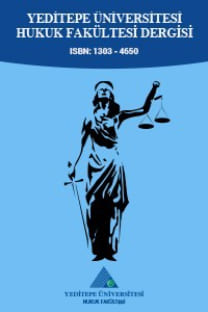AİHM, EĞİTİM KURUMLARINDA DİNİ SEMBOLLER BAĞLAMINDA İNANÇ ÖZGÜRLÜĞÜ HAKKINI NE ÖLÇÜDE TANIMAKTA VE KORUMAKTADIR?
Bölgesel bir mahkeme olarak Avrupa İnsan Hakları Mahkemesi'nin (AİHM) temel hakların geliştirilmesine ve korunmasına katkısı yadsınamaz. Ancak bu makale, AİHM’nin eğitim kurumlarında dini semboller açısından inanç hakkını tanıma ve koruma konusunda ne ölçüde başarılı olduğunu araştırmayı amaçlamaktadır. Bu amaçla, belirli dini sembollere yönelik ve dönüm noktası niteliğinde olan birkaç dava üzerinde durulacaktır. Bu noktada akla bazı sorular gelmektedir. Örneğin, Mahkeme izleme ve denetleme rolünü yeterince üstlenebilmiş midir? Kamusal eğitimde, dini konularda devlet tarafsızlığı ne anlama gelmektedir? Mahkeme, farklı bağlamlarda, yani farklı kültür ve dinlerdeki sembollere ilişkin kararlarında tutarlı olmayı başarabilmiş midir? Mahkeme, çelişkili olduğu iddia edilen ve bu nedenle eleştirilen Şahin (başörtüsü) ve Lautsi (haç) kararlarını nasıl uzlaştırabilir?
Bu sorulara yanıt verebilmek için, kilometre taşı niteliğindeki bu davaların olgusal ve hukuki arka planına ve ilgili düzenleyici çerçeveye kısaca yer verilecektir. Ardından, Mahkeme'nin temel gerekçeleri -dini sembollerin öğrenciler üzerindeki dini yayma etkisi, cinsiyet eşitsizliği ve hoşgörü meseleleri- kapsamlı bir şekilde analiz edilecektir. Mahkemenin sorunlu yaklaşımlarına ve varsa tutarsız yorumlamalarına da aynı bölümde değinilecektir. Ayrıca, takdir yetkisi doktrini, laiklik ilkesi ve tarafsızlık gibi Mahkemenin kararlarında bolca atıf yaptığı bazı ilke ve doktrinler üzerinde durulacaktır.
Anahtar Kelimeler:
başörtüsü ve haç, tutarsız yorumlar, din propagandası yapma, cinsiyet eşitliği, hoşgörü, laiklik
TO WHAT EXTENT DOES THE ECTHR PROMOTE AND PROTECT THE RIGHT TO FREEDOM OF RELIGION IN THE CONTEXT OF RELIGIOUS SYMBOLS AT EDUCATIONAL INSTITUTIONS?
As a regional Court, the European Court of Human Rights' contribution to the development and protection of fundamental rights is undeniable. Yet, this article aims to explore whether and to what extent the European Court has succeeded in recognizing and protecting the right to belief in terms of religious symbols at educational institutions. To that end, a couple of milestone cases addressing certain religious symbols at schools will be elaborated on. At this point, pertinent questions arise; has the Court adequately fulfilled its monitoring role? What does state neutrality on religious matters in public education mean? Has the Court succeeded in being consistent in its decisions on religious symbols in different contexts, i.e., different cultures and religions? How can the Court reconcile its purported contradicting Sahin (headscarf) and Lautsi (crucifix) decisions?
To respond to these and further questions, the factual and legal backgrounds of the milestone cases and the relevant regulatory framework will be briefly provided. Then, the main reasonings of the Court, namely, proselytizing impact of the religious symbols on pupils, gender inequality, and tolerance will be thoroughly analyzed. The problematic approaches and inconsistent interpretations of the Court, if exist, will be touched upon under the same section. Additionally, certain principles and doctrines that the Court adopted such as the doctrine of margin of appreciation, the principle of secularism, and neutrality and impartiality will be elaborated.
Keywords:
headscarf and crucifix, inconsistent interpretations, proselytism, gender equality, tolerance, secularism,
___
- A. C. Romero, ‘The European court of human rights and religion: Between 'Christian' neutrality and the fear of Islam’ (2013) 11 New Zealand Centre for Public Law 75, 22
- A. Ulusoy, ‘Avrupa İnsan Hakları Mahkemesi'nin Üniversitelerde Türban Yasağına İlişkin Kararları Üzerine Notlar’ (2004) 53(4) Ankara Üniversitesi Hukuk Fakültesi Dergisi 1, 130
- C. Evans, Freedom of Religion Under the European Convention on Human Rights, Oxford: Oxford University Press, 2001
- C. Evans, “Islamic Scarf in the European Court of Human Rights”, Melbourne Journal of International Law, Vol. 7, No. 1, 2006, 52.
- C. L. Eisgruber et.al., Religious Freedom and the Constitution (Harvard University Press 2007)
- D. Kyritsis and S. Tsakyrakis, ‘Neutrality in the classroom’ (2013) 11(1) International Journal of Constitutional Law 200
- E. Fokas, ‘Directions in Religious Pluralism in Europe: Mobilizations in the Shadow of European Court of Human Rights Religious Freedom Jurisprudence’ (2015) 4(1) Oxford Journal of Law and Religion, 54
- E. Benvenisti, ‘Margin of Appreciation, Consensus, and Universal Standards’ (1999) 31 New York University Journal of International Law and Politics, 843
- E. Özbudun, Contemporary Turkish Politics: Challenges to a Democratic Consolidation -Lynne Rienner Publishers (2000)
- F. W. Frey, The Turkish Political Elite (MIT Press 1965)
- I.T. Plesner, ‘The European Court of Human Rights: Between Fundamentalist and Liberal Secularism’ in R. Torfs and D. Cole (eds), Islam, Europe and Emerging Legal Issues (Routledge 2016) 63
- J. Gunn, ‘Fearful Symbols: The Islamic Headscarf and the European Court of Human Rights in Sahin v. Turkey’ (2008-2009) 3 Droit et religions Annuaire 341, at 366
- J. Gunn, ‘Adjudicating Rights of Conscience Under the European Convention on Human Rights’ in J. D van der Vyver and J. Witte (eds), Religious Human Rights in Global Perspective: Religious Perspectives, 305
- J. Temperman, “Lautsi II: A Lesson in Bringing Fundamental Children’s Rights”, 6 (3) Religion and Human Rights, 2011
- M. Malik, ‘Complex Equality: Muslim Women and the ‘Headscarf'’ (2008) n°68(1) Droit et société, 127
- S. Mancini, ‘The Crucifix Rage: Supranational Constitutionalism Bumps Against the Counter-Majoritarian Difficulty’ (2010) 6(1) European Constitutional Law Review, 6
- T. Kayaoglu, ‘Trying Islam: Muslims before the European Court of Human Rights’ (2014) 34(4) Journal of Muslim Minority Affairs, 345
- T. Lock, 'Of Crucifixes and Headscarves: Religious Symbols in German Schools' in M. Hunter-Henin (ed), Law, Religious Freedoms and Education in Europe (Cultural Diversity and Law Routledge 2016), 356
- W.C. Durham et al., Islam Europe and Emerging Legal Issues (2016), 354.
- ISSN: 1303-4650
- Başlangıç: 2004
- Yayıncı: Yeditepe Üniversitesi adına Prof. Sultan Tahmazoğlu Üzeltürk
Sayıdaki Diğer Makaleler
SİLAHLI ÇATIŞMALARDA KÜLTÜREL VARLIKLARIN KORUNMASI
Namık Kemal TOPÇU, Neslihan CAN
UNUTULMA HAKKI VE CİNSEL SALDIRI FAİLLERİ
UYUŞTURUCU VEYA UYARICI MADDE KULLANILMASINI KOLAYLAŞTIRMA SUÇU
BİRİCİK OLMA HAKKINA İKİ İTİRAZ
AVRUPA İNSAN HAKLARI MAHKEMESİNİN BİLGİ EDİNME HAKKI - İFADE ÖZGÜRLÜĞÜ İLİŞKİSİNE GÜNCEL YAKLAŞIMI
